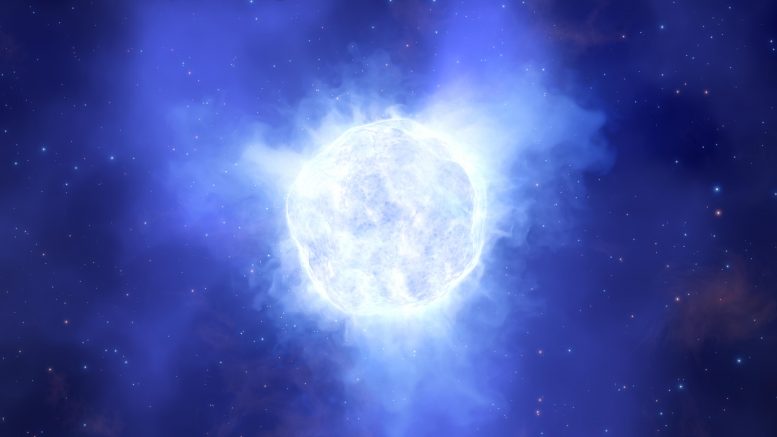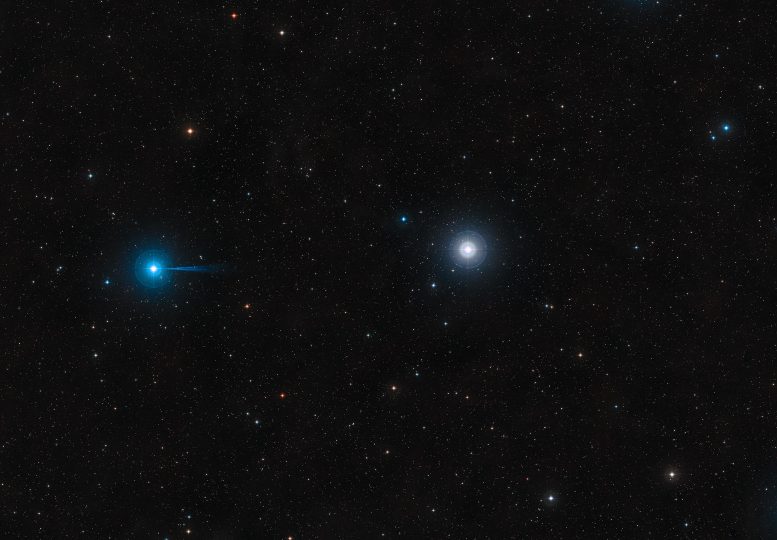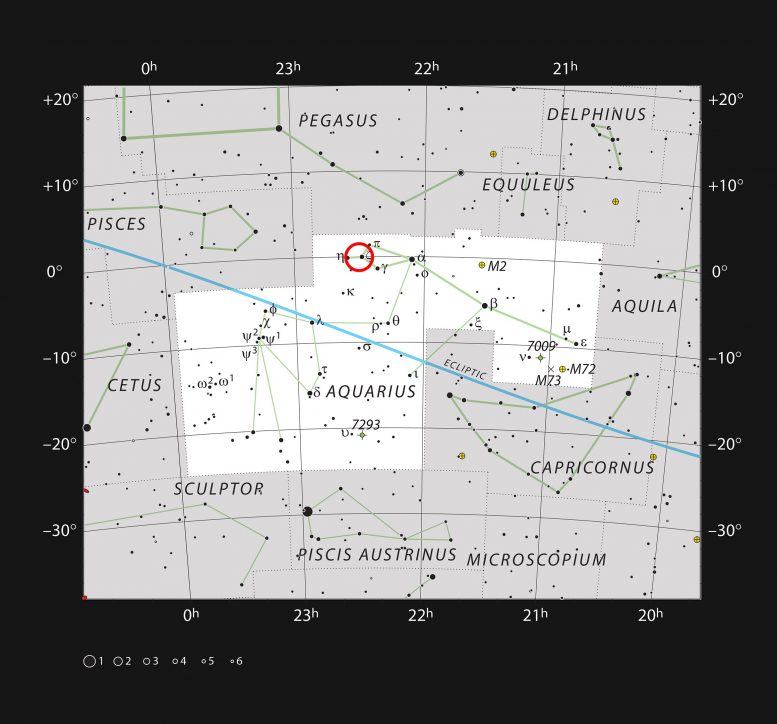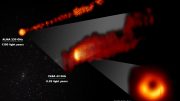
This illustration shows what the luminous blue variable star in the Kinman Dwarf galaxy could have looked like before its mysterious disappearance. Credit: ESO/L. Calçada
Using the European Southern Observatory’s Very Large Telescope (VLT), astronomers have discovered the absence of an unstable massive star in a dwarf galaxy. Scientists think this could indicate that the star became less bright and partially obscured by dust. An alternative explanation is that the star collapsed into a black hole without producing a supernova. “If true,” says team leader and Ph.D. student Andrew Allan of Trinity College Dublin, Ireland, “this would be the first direct detection of such a monster star ending its life in this manner.”
Between 2001 and 2011, various teams of astronomers studied the mysterious massive star, located in the Kinman Dwarf galaxy, and their observations indicated it was in a late stage of its evolution. Allan and his collaborators in Ireland, Chile, and the US wanted to find out more about how very massive stars end their lives, and the object in the Kinman Dwarf seemed like the perfect target. But when they pointed ESO’s VLT to the distant galaxy in 2019, they could no longer find the telltale signatures of the star. “Instead, we were surprised to find out that the star had disappeared!” says Allan, who led a study of the star published today in Monthly Notices of the Royal Astronomical Society.
Astronomers have discovered the absence of an unstable massive star in a dwarf galaxy with ESO’s Very Large Telescope. This video offers a summary of the research.
Located some 75 million light-years away in the constellation of Aquarius, the Kinman Dwarf galaxy is too far away for astronomers to see its individual stars, but they can detect the signatures of some of them. From 2001 to 2011, the light from the galaxy consistently showed evidence that it hosted a ‘luminous blue variable’ star some 2.5 million times brighter than the Sun. Stars of this type are unstable, showing occasional dramatic shifts in their spectra and brightness. Even with those shifts, luminous blue variables leave specific traces scientists can identify, but they were absent from the data the team collected in 2019, leaving them to wonder what had happened to the star. “It would be highly unusual for such a massive star to disappear without producing a bright supernova explosion,” says Allan.

Image of the Kinman Dwarf galaxy, also known as PHL 293B, taken with the NASA/ESA Hubble Space Telescope’s Wide Field Camera 3 in 2011, before the disappearance of the massive star. Located some 75 million light-years away, the galaxy is too far away for astronomers to clearly resolve its individual stars, but in observations done between 2001 and 2011, they detected the signatures of the massive star. These signatures were not present in more recent data. Credit: NASA, ESA/Hubble, J. Andrews (U. Arizona)
The group first turned the ESPRESSO instrument toward the star in August 2019, using the VLT’s four 8-meter telescopes simultaneously. But they were unable to find the signs that previously pointed to the presence of the luminous star. A few months later, the group tried the X-shooter instrument, also on ESO’s VLT, and again found no traces of the star.
“We may have detected one of the most massive stars of the local Universe going gently into the night,” says team member Jose Groh, also of Trinity College Dublin. “Our discovery would not have been made without using the powerful ESO 8-meter telescopes, their unique instrumentation, and the prompt access to those capabilities following the recent agreement of Ireland to join ESO.” Ireland became an ESO member state in September 2018.
This animation shows what the luminous blue variable star in the Kinman Dwarf galaxy could have looked like before its mysterious disappearance.
The team then turned to older data collected using X-shooter and the UVES instrument on ESO’s VLT, located in the Chilean Atacama Desert, and telescopes elsewhere.“The ESO Science Archive Facility enabled us to find and use data of the same object obtained in 2002 and 2009,” says Andrea Mehner, a staff astronomer at ESO in Chile who participated in the study. “The comparison of the 2002 high-resolution UVES spectra with our observations obtained in 2019 with ESO’s newest high-resolution spectrograph ESPRESSO was especially revealing, from both an astronomical and an instrumentation point of view.”

This wide-field view shows the region of the sky, in the constellation of Aquarius, where the Kinman Dwarf galaxy can be found. This view was created from images forming part of the Digitized Sky Survey 2. Credit: ESO/Digitized Sky Survey 2. Acknowledgment: Davide De Martin
The old data indicated that the star in the Kinman Dwarf could have been undergoing a strong outburst period that likely ended sometime after 2011. Luminous blue variable stars such as this one are prone to experiencing giant outbursts over the course of their life, causing the stars’ rate of mass loss to spike and their luminosity to increase dramatically.
This video starts by showing a wide-field view of a region of the sky in the constellation of Aquarius. It then zooms in to show the Kinman Dwarf galaxy, where a mysterious luminous blue variable star disappeared. The end of the video shows an artistic animation of what the star could have looked like before it disappeared.
Based on their observations and models, the astronomers have suggested two explanations for the star’s disappearance and lack of a supernova, related to this possible outburst. The outburst may have resulted in the luminous blue variable being transformed into a less luminous star, which could also be partly hidden by dust. Alternatively, the team says the star may have collapsed into a black hole, without producing a supernova explosion. This would be a rare event: our current understanding of how massive stars die points to most of them ending their lives in a supernova.
Future studies are needed to confirm what fate befell this star. Planned to begin operations in 2025, ESO’s Extremely Large Telescope (ELT) will be capable of resolving stars in distant galaxies such as the Kinman Dwarf, helping to solve cosmic mysteries such as this one.

This chart shows the location of the Kinman Dwarf galaxy, where a mysterious luminous blue variable star disappeared. This map shows most of the stars visible to the unaided eye under good conditions and the system itself is marked with a red circle. Credit: ESO, IAU and Sky & Telescope
Reference: “The possible disappearance of a massive star in the low metallicity galaxy PHL 293B” by Andrew P. Allan, Jose H. Groh, Andrea Mehner, Nathan Smith, Ioana Boian, Eoin J. Farrell and Jennifer E. Andrews, 30 June 2020, Monthly Notices of the Royal Astronomical Society.
DOI: 10.1093/mnras/staa1629
The team is composed of Andrew Allan (School of Physics, Trinity College Dublin, Ireland [TCD]), Jose J. Groh (TCD), Andrea Mehner (European Southern Observatory, Chile), Nathan Smith (Steward Observatory, University of Arizona, USA [Steward Observatory]), Ioanna Boian (TCD), Eoin Farrell (TCD), Jennifer E. Andrews (Steward Observatory).
ESO is the foremost intergovernmental astronomy organization in Europe and the world’s most productive ground-based astronomical observatory by far. It has 16 Member States: Austria, Belgium, the Czech Republic, Denmark, France, Finland, Germany, Ireland, Italy, the Netherlands, Poland, Portugal, Spain, Sweden, Switzerland and the United Kingdom, along with the host state of Chile and with Australia as a Strategic Partner. ESO carries out an ambitious program focused on the design, construction and operation of powerful ground-based observing facilities enabling astronomers to make important scientific discoveries. ESO also plays a leading role in promoting and organizing cooperation in astronomical research. ESO operates three unique world-class observing sites in Chile: La Silla, Paranal and Chajnantor. At Paranal, ESO operates the Very Large Telescope and its world-leading Very Large Telescope Interferometer as well as two survey telescopes, VISTA working in the infrared and the visible-light VLT Survey Telescope. Also at Paranal ESO will host and operate the Cherenkov Telescope Array South, the world’s largest and most sensitive gamma-ray observatory. ESO is also a major partner in two facilities on Chajnantor, APEX and ALMA, the largest astronomical project in existence. And on Cerro Armazones, close to Paranal, ESO is building the 39-meter Extremely Large Telescope, the ELT, which will become “the world’s biggest eye on the sky.”









A star can’t “disappear. Some galaxies may contain high concentrations of dark matter that change shape under gravitational forces. It’s possible that the light emanating from this star has been occluded by a dense concentration of dark matter.